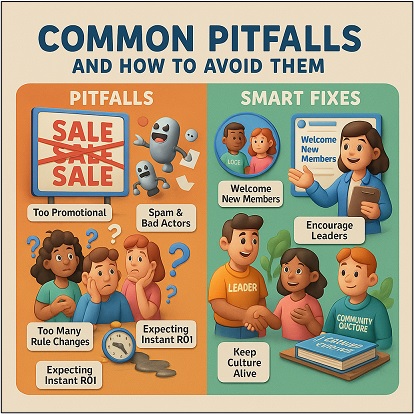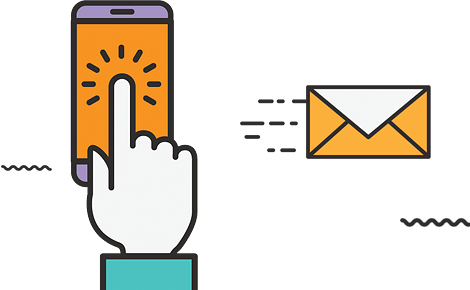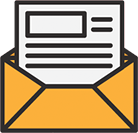Facebook Groups as Community Builders

If you want deeper connections with customers, a Facebook Group is one of the smartest places to start. It’s not an ad slot or a campaign.
It is a space where people gather, talk, and stick around. Facebook still moves huge audiences, and Groups let you meet them in smaller circles that actually care about what you do.
Done right, a group turns casual buyers into repeat customers and satisfied members into vocal advocates.
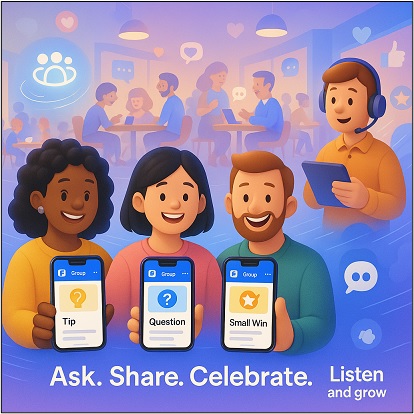
Why Community Matters in 2025?

People crave belonging. They want to ask questions, trade tips and feel heard. A group answers that need.
It gives members a place to compare notes, share wins, and surface problems. For brands, that’s gold. You get direct feedback, real conversations, and unpair promotion when members recommend your product.
Compared with one-way ads, groups create two-way relationships. That changes the tone of your marketing from pushy to helpful.
What Makes Facebook Groups Effective for Marketing
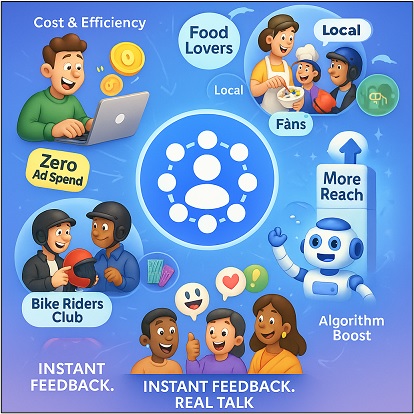
Groups are targeted by design.
You can build niche spaces, such as local chapters, hardcore users, or specific product fans. They’re cheap to run.
There’s no media buy required to post. They provide fast feedback. Members flag problems and suggest fixes in real time.
Also, there’s an algorithm tailwind. Facebook tends to surface active group content more than generic page posts. Organic reach still matters in a world drowning in paid messages.
Getting Started With a Clear Purpose
Every group needs a reason to exist. Pick one and stick to it.
Is the group for product support?
For expert tips? For local meetups?
Define the promise in the description. That attracts the right people and keeps discussions on-topic. A narrow focus beats a vague “brand fans” community any day.

Day-to-day Content That Works
Content keeps a group alive. Mix formats and keep it practical.
- Short how-tos and quick demos.
- Member spotlights and success stories.
- Polls that ask real questions.
- Live Q&A sessions with product folks.
- Behind-the-scenes snippets that humanize the brand.
Ask for user-generated content. When members post photos or review engagement climbs and you get authentic material to repurpose.
Rules, Moderation and Tone
A safe, friendly space keeps people coming back. Set clear rules and punish them. Enforce them gently but firmly. Appoint trusted moderators once the group grows. Give members a role such as volunteer moderators, topic leads, or regular champions. Community ownership reduces your workload and raises trust.
Incentives That Actually Work
People join for value. Offer perks that make membership worthwhile. This can include exclusive promos, early product access, or members-only events. Run small contests and challenges with meaningful rewards. The goal isn’t giveaways; it’s consistent activity and loyalty.
Measurement – What to Watch
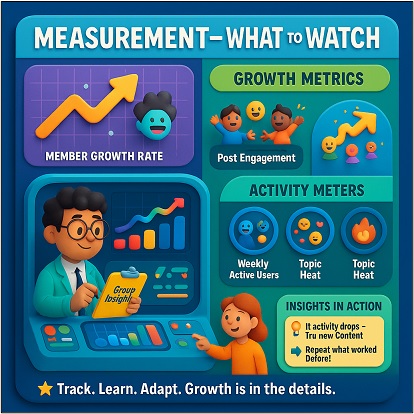
Groups are measurable if you track the right signals:
- Member growth rate: Are you gaining the right members?
- Weekly active users: Who’s actually showing up?
- Post Engagement: Comments, reacts, and shares.
- Topic Heat: Which threads get traction.
- Referral Behavior: Do members bring new customers?
Use these signals to adapt. If activity drops, try new content types or rerun a successful event.
Using Group Features to Your Advantage
Pin announcements for launches and policy updates. Use units or guides to build helpful resource hubs. Host events for product training or community meetups. The “ask to join” funnel helps filter out irrelevant bots and keep quality high.
Examples that Show the Formula

Real brands show how groups scale impact.
- A fitness company runs daily challenges and spotlight posts that lift loyalty and boost subscription renewals.
- A design tool hosts tutorials and peer review threads—users help each other and recommend the product in other channels.
- A lifestyle brand gives members early access to drops and private discounts, turning the group into a revenue driver.
These aren’t one-off wins. They’re repeatable plays built on consistent value and active moderation.
Common Pitfalls and How to Avoid Them
Don’t treat the group like a billboard. Heavy promotional posts kill engagement. Don’t let spam or bad actors run unchecked. Avoid too many rule changes—members dislike surprises. And don’t expect instant ROI. Community building takes time and steady attention.
Scaling Without Losing Warmth
As the group grows, keep the culture tight. Split large communities into subgroups by interest or location. Recruit volunteer leaders. Keep onboarding clear with pinned welcome posts. Preserve the group’s core vibe by documenting the culture and training new moderators.
Quick checklist for launch

- Define purpose and target member.
- Write clear rules and a pinned welcome.
- Post a content calendar for the first 30 days.
- Recruit two moderators from day one.
- Offer one exclusive perk to new members.
- Track engagement and iterate weekly.
Final thoughts
Facebook Groups aren’t a replacement for paid media. They’re a companion channel that builds loyalty, informs product decisions, and lowers acquisition costs through word-of-mouth. If you want sustained advocacy, start small, add real value, and keep the community safe and useful. When you scale campaigns or manage significant budgets tied to community outcomes, consider tapping an experienced community manager or agency to avoid common mistakes and protect your brand’s reputation.





